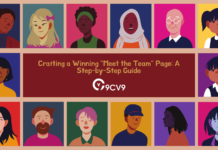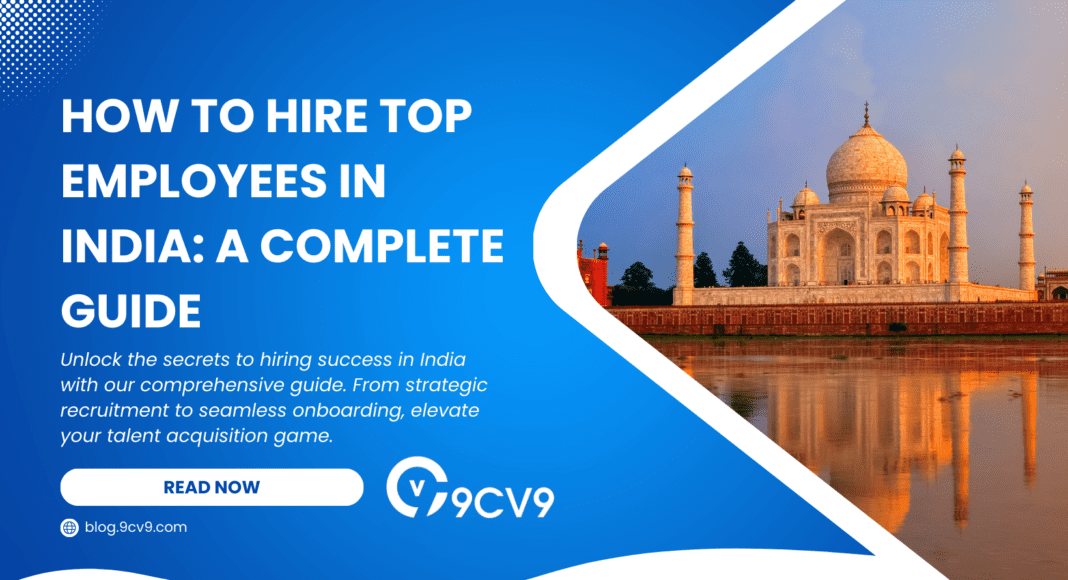Key Takeaways
- Strategic Talent Identification: Uncover hidden talent pools and niche skills with advanced recruitment strategies, positioning your organization as a magnet for top-tier professionals in India.
- Efficient Hiring Processes: Streamline your recruitment journey with technology-driven initial screenings, optimized candidate assessments, and a commitment to transparency, ensuring agility and competitiveness in the dynamic job market.
- Seamless Onboarding for Long-Term Success: Craft a compelling onboarding experience to transform new hires into thriving contributors. From comprehensive training to cultural immersion, lay the foundation for sustained success in India’s vibrant and diverse work environment.
Welcome to our in-depth guide on mastering the art of hiring top-tier talent in the dynamic and competitive job market of India.
As businesses strive for excellence and growth, the cornerstone of success lies in assembling a team of exceptional individuals who not only meet the job requirements but also bring unparalleled skills, innovation, and dedication to the table.
India, with its diverse and rapidly evolving economy, offers a rich pool of talent across various industries. However, navigating the complexities of the hiring process can be a daunting task, especially when the goal is to attract and retain the best minds in the business.

That’s where this comprehensive guide steps in – to serve as your roadmap to not just hiring employees, but cultivating a workforce that propels your organization to new heights.
Unveiling the Landscape of India’s Job Market
To embark on this journey, it’s crucial to understand the pulse of India’s job market.
We’ll delve into the latest trends shaping industries, pinpoint the skills that are in high demand, and unravel the intricacies of competing for the attention of top-tier talent in a landscape where choices are abundant.
Cutting-Edge Recruitment Strategies for the Digital Era
In a world driven by technology and connectivity, traditional hiring methods may fall short in attracting the best talent.
Our guide will walk you through advanced recruitment strategies, leveraging the power of digital platforms, social media, and innovative networking techniques to ensure your job openings reach the right eyes.
Also, read our top guide on the Top 10 Best Employment Agencies in India to Hire Employees.
Crafting Job Descriptions That Captivate
A well-crafted job description is your first line of defense in the battle for top talent.
We’ll explore the art of keyword optimization, creating attention-grabbing titles, and structuring job descriptions that not only align with search engine algorithms but also resonate with the aspirations of prospective employees.
Streamlining the Hiring Process for Efficiency
Time is of the essence, and a streamlined hiring process can make all the difference.
From simplifying application procedures to implementing cutting-edge applicant tracking systems, we’ll guide you on how to efficiently navigate the stages from application to hire, ensuring a smooth and swift recruitment journey.
Navigating the Art of Salary Negotiations
One of the critical junctures in hiring top talent lies in negotiating a compensation package that aligns with industry standards and meets the expectations of your prospective employees.
Our guide will equip you with strategies to research competitive compensation packages, handle negotiations with finesse, and ultimately secure the commitment of the best candidates.
Onboarding for Success: Beyond the First Day
The journey doesn’t end with an acceptance letter.
We’ll explore the intricacies of onboarding processes designed for long-term success, ensuring that your new employees not only settle in seamlessly but also embark on a journey of continuous learning, development, and integration into your organizational culture.
Join us as we unravel the complexities of hiring top employees in India – a journey that goes beyond the conventional, paving the way for a workforce that propels your business towards unparalleled success.
Let’s dive deep into the nuances, strategies, and best practices that will transform your hiring process into a magnet for top-tier talent. Welcome to your complete guide to mastering the art of hiring in India.
Before we venture further into this article, we like to share who we are and what we do.
About 9cv9
9cv9 is a business tech startup based in Singapore and Asia with a strong presence all over the world.
With over eight years of startup and business experience, and being highly involved in connecting with thousands of companies and startups, the 9cv9 team has listed some important learning points in this overview of How to Hire Top Employees in India.
If your company needs recruitment and headhunting services to hire top employees in India, you can use 9cv9 headhunting and recruitment services to hire top talents and candidates. Find out more here, or send over an email to [email protected].
Or just post 1 free job posting here at 9cv9 Hiring Portal in under 10 minutes.
How to Hire Top Employees in India: A Complete Guide
- Identifying Top Talent in India
- Crafting Compelling Job Descriptions
- Streamlining the Hiring Process
- Navigating Salary Negotiations
- Onboarding and Integration
1. Identifying Top Talent in India
Unveiling the Indian Job Market Trends
In the vast and ever-evolving landscape of India’s job market, staying abreast of trends is paramount to identifying and attracting top talent.

Let’s explore the current dynamics that shape industries and influence the choices of prospective employees.
- Industry Overview
- Conduct a thorough analysis of key industries in India, such as Information Technology, Healthcare, Finance, and E-commerce.
- Example: The IT sector in India has witnessed significant growth, with a surge in demand for skilled professionals in areas like artificial intelligence, data science, and cybersecurity.
- Emerging Skills and Qualifications
- Identify the in-demand skills that are crucial for success in today’s competitive job market.
- Example: With the rise of digital transformation, skills like blockchain development and cloud computing have become highly sought after across various industries.
- Understanding Market Competition
- Gauge the level of competition for top talent within your industry and geographical location.
- Example: In metropolitan areas like Bangalore and Mumbai, where the tech industry thrives, the competition for skilled IT professionals is intense.
Leveraging Advanced Recruitment Strategies
In a digital age, traditional recruitment methods may not suffice when targeting top talent.
Employing cutting-edge strategies ensures your job openings reach the right audience and resonate with potential candidates.
- Technology in Recruitment
- Leverage technology tools, including AI-driven recruitment platforms and chatbots, to streamline the initial stages of the hiring process.
- Example: Implementing a chatbot on your career page can provide instant responses to candidate queries, creating a positive and responsive user experience.
- Social Media Presence
- Establish a strong presence on social media platforms to showcase your company culture and job opportunities.
- Example: Utilize LinkedIn not only for job postings but also for sharing engaging content that highlights your workplace culture and employee success stories.
- Networking Events and Industry Partnerships
- Actively participate in industry-specific events and forge partnerships to tap into specialized talent pools.
- Example: Sponsoring or participating in tech conferences can connect you with skilled professionals in the IT sector, fostering relationships for future hires.
Crafting Compelling Job Descriptions
A well-crafted job description serves as a magnet for top talent.
Employing strategies to optimize job listings ensures they are not only appealing to potential candidates but are also discoverable in online searches.
- Keyword Optimization
- Identify and incorporate relevant keywords in your job descriptions to enhance search engine visibility.
- Example: If you’re hiring for a data scientist role, include keywords such as “machine learning,” “Python,” and “big data analytics” to attract candidates with the right skill set.
- Attention-Grabbing Titles
- Create job titles that are both accurate and appealing to stand out in a sea of listings.
- Example: Instead of a generic “Software Engineer,” consider “Senior AI Software Engineer – Pioneering Innovative Solutions” to attract experienced professionals with a passion for cutting-edge technology.
- Optimizing for Search Engines
- Structure your job descriptions in a way that aligns with search engine algorithms, making them more likely to appear in relevant search results.
- Example: Ensure your job descriptions include location-specific information to capture local talent actively searching for opportunities in their area.
In the journey to identify top talent in India, combining an understanding of market trends with innovative recruitment strategies and compelling job descriptions is key.
Stay tuned as we navigate the subsequent stages of the hiring process, unraveling the complexities of recruitment in one of the world’s most dynamic job markets.
2. Crafting Compelling Job Descriptions
Understanding the Importance of Job Descriptions
Crafting compelling job descriptions is a critical step in attracting top talent in the vibrant job market of India.
A well-articulated job description not only communicates the responsibilities of the role but also serves as a powerful marketing tool to entice qualified candidates.

- Key Elements of Job Descriptions
- Clearly outline the role’s responsibilities, qualifications, and expectations.
- Example: For a software developer position, specify the programming languages, frameworks, and project types the candidate will be working on.
Harnessing the Power of Keywords
Optimizing job descriptions with relevant keywords is essential for ensuring visibility on search engines and attracting candidates who possess the right skills.
- Identifying Relevant Keywords
- Research and incorporate industry-specific and role-relevant keywords.
- Example: If hiring for a content marketing role, include keywords such as “SEO,” “content strategy,” and “digital marketing” to attract candidates with expertise in these areas.
- Geo-Targeting Keywords
- Include location-specific keywords to target candidates in specific regions.
- Example: If the job is based in Bangalore, use phrases like “Bangalore-based” or “work in Bangalore” to appeal to local candidates.
Crafting Attention-Grabbing Titles
The job title is often the first thing potential candidates see. A creative and accurate title can make your job listing stand out among the multitude of opportunities available.
- Balancing Creativity and Clarity
- Craft titles that are both attention-grabbing and clearly convey the nature of the role.
- Example: Instead of “Marketing Specialist,” consider “Innovative Marketing Guru – Transforming Brands in a Digital Era” to intrigue candidates.
- Incorporating Seniority Levels
- Clearly indicate the seniority level of the role to attract candidates at the appropriate career stage.
- Example: Use terms like “Junior,” “Senior,” or “Lead” in the title to signal the level of expertise required.
Utilizing Persuasive Language
The language used in job descriptions plays a crucial role in conveying the company culture, values, and the exciting aspects of the role.
- Showcasing Company Culture
- Integrate language that reflects the company’s values, mission, and workplace culture.
- Example: If your company values innovation and collaboration, use phrases like “Join a dynamic team fostering creativity and teamwork.”
- Highlighting Impact and Growth Opportunities
- Emphasize the impact the role will have on the company and any growth opportunities available.
- Example: “Contribute to groundbreaking projects and unlock your potential for career advancement in a rapidly growing organization.”
Optimizing for Search Engines
Structuring job descriptions to align with search engine algorithms is crucial for enhanced visibility.
- Formatting for Readability
- Use clear headings, bullet points, and concise paragraphs for easy readability.
- Example: Break down responsibilities into bullet points for easy scanning, making it more accessible to busy professionals.
- Mobile Optimization
- Ensure job descriptions are mobile-friendly to cater to candidates who browse on smartphones.
- Example: A mobile-optimized job description allows candidates to explore opportunities seamlessly on their devices.
Showcasing Compensation and Benefits
Including details about compensation and benefits can attract candidates who align with the offered package.
- Transparent Compensation Information
- Clearly state the salary range or benefits to set expectations from the beginning.
- Example: “Competitive salary commensurate with experience and performance, along with health insurance and performance bonuses.”
- Highlighting Perks and Unique Selling Points
- Showcase additional perks or unique selling points to make your offer more enticing.
- Example: “Enjoy flexible work hours, wellness programs, and company-sponsored professional development opportunities.”
Incorporating Inclusive Language
Employing inclusive language ensures that your job descriptions appeal to a diverse range of candidates.
- Avoiding Gender-Biased Language
- Use gender-neutral terms to appeal to a broad audience.
- Example: Instead of “salesman,” use “sales representative” to make the position more inclusive.
- Emphasizing Diversity and Equal Opportunity
- Explicitly state the company’s commitment to diversity and equal opportunity.
- Example: “We are an equal opportunity employer and encourage candidates from all backgrounds to apply.”
Tailoring Job Descriptions for Cultural Fit
Highlighting aspects of your company’s work culture helps attract candidates who align with your organizational values.
- Describing Work Environment
- Provide insights into the work environment and team dynamics.
- Example: “Join a collaborative and innovative team where ideas are valued, and employees thrive in a supportive work culture.”
- Emphasizing Core Values
- Clearly articulate the company’s core values and how they align with the expectations for the role.
- Example: “Our commitment to integrity, excellence, and teamwork defines the foundation of our workplace culture.”
Encouraging Action and Application
Concluding job descriptions with a compelling call-to-action prompts potential candidates to take the next step.
- Clear Application Instructions
- Provide straightforward instructions on how to apply.
- Example: “To apply, please submit your resume and a cover letter detailing your relevant experience and why you’re excited about this opportunity.”
- Highlighting Application Deadlines
- If applicable, include any deadlines for application submissions.
- Example: “Applications accepted until [date], so apply now to be considered for this exciting role.”
In summary, crafting compelling job descriptions is a strategic process that involves the artful use of language, optimization for search engines, and a keen understanding of what top talent seeks in a role.
By implementing these practices, your organization can create job listings that not only attract high-caliber candidates but also align with your company’s values and vision.
Stay tuned as we delve deeper into the intricacies of the hiring process, offering insights and strategies for success in the competitive Indian job market.
3. Streamlining the Hiring Process
Embracing Efficiency in the Hiring Process
Streamlining the hiring process is paramount when aiming to secure top talent in the competitive job market of India.
A well-organized and efficient hiring process not only attracts top candidates but also ensures a positive candidate experience.
Let’s explore the key strategies and best practices to streamline your hiring process effectively.

Utilizing Technology for Initial Screening
- Applicant Tracking Systems (ATS)
- Implement an ATS to automate the initial screening of resumes, saving time and ensuring consistency.
- Example: An ATS can automatically filter applications based on specified criteria, such as relevant skills and experience, streamlining the shortlisting process.
- Video Interviews
- Conduct preliminary video interviews to assess candidates’ communication skills and cultural fit.
- Example: Platforms like Zoom or Microsoft Teams facilitate virtual interviews, enabling you to efficiently connect with candidates regardless of their geographical location.
- Online Assessments
- Leverage online assessments to evaluate candidates’ skills and competencies.
- Example: For technical roles, platforms like HackerRank or Codility offer coding challenges to assess programming proficiency.
Creating Efficient Application Processes
- Simplified Application Forms
- Design straightforward and user-friendly application forms to reduce friction for candidates.
- Example: Lengthy and complex application forms can deter qualified candidates, so ensure that the application process is quick and intuitive.
- Mobile Optimization
- Optimize the application process for mobile devices to accommodate candidates who prefer applying via smartphones or tablets.
- Example: A mobile-optimized application process ensures accessibility for candidates on the go, widening your talent pool.
- Realistic Job Previews
- Provide candidates with a realistic preview of the job and company culture to manage expectations.
- Example: A brief video tour of the workplace or testimonials from current employees can offer valuable insights to prospective candidates.
Efficient Interviewing Techniques
- Structured Interviews
- Implement structured interviews with predefined questions to ensure a fair and consistent evaluation process.
- Example: Create an interview guide with standardized questions that assess specific competencies relevant to the role.
- Panel Interviews
- Conduct panel interviews to involve multiple perspectives in the evaluation process.
- Example: A panel comprising team members, HR representatives, and department heads can provide a holistic assessment of a candidate’s suitability.
- Timely Feedback
- Provide timely feedback to candidates to maintain transparency and uphold a positive candidate experience.
- Example: Inform candidates about the expected timeline for feedback, and adhere to it to demonstrate your organization’s commitment to efficiency.
Optimizing Candidate Assessments
- Role-Specific Assessments
- Tailor assessments to reflect the specific skills and competencies required for the role.
- Example: If hiring for a sales position, include a role-playing scenario as part of the assessment to evaluate candidates’ sales acumen.
- Behavioral Assessments
- Utilize behavioral assessments to gauge candidates’ cultural fit and alignment with the company’s values.
- Example: Ask situational questions that prompt candidates to share experiences demonstrating their problem-solving or teamwork skills.
- Cultural Fit Evaluation
- Incorporate elements in the assessment process to evaluate candidates’ compatibility with the company culture.
- Example: Include questions that delve into candidates’ work preferences, collaboration styles, and alignment with the company’s core values.
Implementing Transparent Communication
- Clear Communication Channels
- Establish clear channels for communication between candidates and the hiring team.
- Example: Maintain an active email address or dedicated communication platform for candidates to inquire about the status of their application.
- Feedback Loop
- Create a feedback loop where candidates receive constructive feedback even if they are not selected.
- Example: Providing feedback allows candidates to understand areas for improvement and enhances their overall experience with the hiring process.
- Setting Realistic Expectations
- Clearly communicate the steps of the hiring process, expected timelines, and potential delays.
- Example: Inform candidates about the stages of the process, from initial screening to final interviews, to manage their expectations effectively.
Leveraging Employer Branding for Efficiency
- Consistent Brand Messaging
- Ensure that your employer branding is consistent across all communication channels.
- Example: Consistent messaging reinforces your organization’s values and identity, making it easier for candidates to identify with your brand.
- Showcasing Employee Success Stories
- Highlight success stories of current employees who have thrived in the organization.
- Example: Featuring testimonials or short profiles of employees who joined through similar hiring processes can build trust and attract top talent.
- Utilizing Social Media
- Leverage social media platforms to showcase your company culture, values, and ongoing projects.
- Example: Regularly posting updates on platforms like LinkedIn or Instagram gives potential candidates a glimpse into the day-to-day life at your organization.
Continuous Improvement through Data Analysis
- Analytics for Process Evaluation
- Implement analytics tools to evaluate the efficiency of your hiring process continually.
- Example: Analyzing data on time-to-fill, candidate drop-off rates, and interview-to-offer ratios provides insights into areas for improvement.
- Candidate Experience Surveys
- Collect feedback from candidates through surveys to assess their overall experience.
- Example: A post-hiring process survey can help identify pain points and areas where candidates felt the process could be enhanced.
Conclusion: A Strategic Approach to Hiring Efficiency
Streamlining the hiring process is a strategic endeavor that involves leveraging technology, optimizing application processes, refining interview techniques, and continuously improving based on data analysis and candidate feedback.
By embracing efficiency, your organization can attract, evaluate, and secure top talent in the bustling job market of India, setting the stage for sustained success and growth.
4. Navigating Salary Negotiations
Understanding the Dynamics of Salary Negotiations in India
Navigating salary negotiations is a crucial aspect of hiring top talent in India’s competitive job market.
By adopting a strategic and informed approach, employers can attract and retain skilled professionals while ensuring a fair and mutually beneficial compensation package.
Let’s explore the key considerations and best practices for successful salary negotiations.
Researching Competitive Compensation Packages
- Benchmarking Industry Standards
- Conduct thorough research to understand the prevailing salary standards within your industry and location.
- Example: In the IT sector, a senior software developer in Bangalore might command a higher salary than in a tier-2 city due to cost-of-living differences.
- Utilizing Salary Surveys
- Refer to industry-specific salary surveys and reports to gain insights into current compensation trends.
- Example: Surveys by organizations like NASSCOM for the IT industry provide comprehensive data on salary ranges for different roles.
- Consideration of Regional Variances
- Account for regional variations in living costs when determining salary ranges.
- Example: An organization with offices in multiple cities should consider adjusting salaries based on the cost of living in each location.
Negotiation Strategies for Top Talent
- Customizing Packages for Individuals
- Tailor compensation packages to meet the individual needs and preferences of top-tier candidates.
- Example: Offering flexible work arrangements, such as remote options or adjusted working hours, can be an attractive negotiating point.
- Incorporating Non-Monetary Incentives
- Highlight non-monetary benefits, such as healthcare plans, stock options, or professional development opportunities.
- Example: An organization might offer a comprehensive healthcare package that covers medical, dental, and vision expenses to enhance its overall compensation package.
- Performance-Based Incentives
- Introduce performance-based incentives tied to key performance indicators (KPIs) to motivate and reward high-performing employees.
- Example: Sales professionals might negotiate for a commission structure tied to revenue targets, aligning their compensation with their contribution to the company’s success.
Navigating Cultural Nuances in Negotiations
- Understanding Cultural Expectations
- Be aware of cultural nuances that may influence salary expectations and negotiation styles.
- Example: In India, it’s common for candidates to negotiate, and the negotiation process is often seen as a way to establish mutual respect.
- Building Long-Term Relationships
- Focus on building long-term relationships by emphasizing the value of the employee within the organization.
- Example: Highlighting opportunities for career growth and professional development can appeal to candidates seeking a holistic employment experience.
- Flexibility in Negotiations
- Demonstrate flexibility in negotiations to accommodate cultural preferences and individual circumstances.
- Example: Allowing negotiation discussions to be open and collaborative, rather than rigid, can contribute to a positive negotiation experience.
Salary Transparency and Open Communication
- Transparent Communication
- Foster open communication about the salary structure and how it aligns with the candidate’s skills and experience.
- Example: Clearly articulate how the salary offered reflects the candidate’s expertise and the market value for the role.
- Setting Realistic Expectations
- Manage expectations by providing a clear understanding of the organization’s salary policies and limitations.
- Example: If the organization has set salary bands for certain roles, communicate this information transparently to candidates.
- Addressing Salary History
- Address any discussions about the candidate’s salary history with sensitivity and focus on the current market value.
- Example: Instead of relying on past salary figures, emphasize the competitive nature of the current offer based on industry benchmarks.
Overcoming Potential Challenges
- Budget Constraints
- If facing budget constraints, be transparent about limitations and explore alternative benefits or perks.
- Example: An organization may offer additional vacation days, flexible work hours, or training opportunities as alternatives to meeting a candidate’s salary expectations.
- Handling Counteroffers
- Strategically handle counteroffers by assessing the candidate’s value to the organization and the feasibility of meeting their expectations.
- Example: When presented with a counteroffer, consider the overall impact on team dynamics, project timelines, and the organization’s budget.
- Negotiating Entry-Level Salaries
- For entry-level positions, emphasize growth opportunities, training programs, and mentorship to compensate for potentially lower starting salaries.
- Example: An entry-level candidate might be more enticed by the prospect of rapid career advancement and skill development than an immediate high salary.
Legal and Ethical Considerations
- Compliance with Labor Laws
- Ensure that salary negotiations comply with local labor laws and regulations.
- Example: In India, adherence to statutory requirements, such as minimum wages and mandatory benefits, is essential to avoid legal complications.
- Equal Pay Principles
- Uphold principles of equal pay for equal work, promoting fairness and equality within the organization.
- Example: Regularly review salary structures to identify and rectify any gender or diversity-related pay gaps.
- Confidentiality Agreements
- Consider the use of confidentiality agreements to protect sensitive information discussed during negotiations.
- Example: Confidentiality agreements can reassure candidates that their salary negotiations will be handled discreetly.
Negotiation Etiquette and Best Practices
- Professionalism in Communication
- Maintain professionalism in all communication, emphasizing respect and a collaborative approach.
- Example: Responding promptly to negotiation-related queries and keeping the tone positive contributes to a constructive negotiation atmosphere.
- Timely Decision-Making
- Aim for timely decision-making to avoid unnecessary delays that may impact a candidate’s perception of the organization.
- Example: A streamlined decision-making process, including swift approval of offers, demonstrates the organization’s commitment to efficiency.
- Documenting Agreements
- Document agreed-upon terms in writing to avoid misunderstandings and provide clarity for both parties.
- Example: A formal offer letter should clearly outline the terms and conditions of employment, including salary, benefits, and any negotiated terms.
Navigating salary negotiations in India requires a strategic blend of research, cultural understanding, transparency, and effective communication.
By embracing flexibility, recognizing individual needs, and aligning compensation packages with market standards, organizations can successfully attract and retain top talent in this dynamic job market.
Stay tuned as we delve deeper into the intricacies of hiring in India, unraveling more insights and strategies for success in the competitive landscape.
5. Onboarding and Integration
Crafting a Seamless Onboarding Experience for Top Talent in India
Effective onboarding and integration processes are pivotal in securing and retaining top-tier talent in India’s competitive job market.
A well-designed onboarding strategy not only ensures a smooth transition for new hires but also contributes to their long-term success within the organization.
Let’s explore key components and best practices for creating a seamless onboarding and integration experience.

Pre-Onboarding Preparation
- Welcome Kit and Information
- Provide a comprehensive welcome kit containing essential information about the organization, its culture, and policies.
- Example: Include a personalized welcome letter, an organizational chart, and a handbook outlining company policies.
- Technology Setup
- Ensure that the new hire’s technology setup is ready before their first day, including a fully configured workstation and necessary software access.
- Example: IT teams can coordinate to have computers, email accounts, and necessary software licenses ready in advance.
- Assigned Buddy or Mentor
- Assign a seasoned employee as a buddy or mentor to guide the new hire through the initial days.
- Example: A buddy system fosters a sense of belonging and helps new hires navigate the company culture and work dynamics.
First-Day Welcome and Orientation
- Welcome Ceremony
- Conduct a formal welcome ceremony on the first day to introduce the new hire to the team and leadership.
- Example: Hosting a welcome lunch or brief introduction meeting allows new hires to connect with colleagues in a relaxed setting.
- Company Overview Session
- Arrange a session to provide an overview of the company’s history, mission, and vision.
- Example: Executives or senior leaders can share insights into the organization’s journey, emphasizing its values and future aspirations.
- Role and Responsibilities Discussion
- Engage in a detailed discussion about the new hire’s role, responsibilities, and expectations.
- Example: A one-on-one session with the hiring manager can provide clarity on job responsibilities, performance metrics, and growth opportunities.
Comprehensive Training Programs
- Job-Specific Training
- Implement job-specific training programs to equip new hires with the skills and knowledge needed for their roles.
- Example: A software development team may provide coding workshops or deep-dive sessions into the organization’s tech stack.
- Soft Skills Development
- Include sessions focusing on soft skills development, such as communication, teamwork, and time management.
- Example: Workshops on effective communication or team-building exercises can enhance collaboration within the new hire’s team.
- Cross-Functional Understanding
- Foster cross-functional understanding by providing insights into various departments and their roles.
- Example: Organizing shadowing opportunities or interdepartmental training sessions can broaden new hires’ perspectives on the organization.
Cultural Immersion and Inclusion
- Introduction to Organizational Culture
- Facilitate sessions that delve into the organizational culture, values, and unwritten norms.
- Example: Sharing real-life examples or success stories that exemplify the company’s culture can help new hires align with its ethos.
- Diversity and Inclusion Initiatives
- Emphasize diversity and inclusion initiatives, showcasing the organization’s commitment to creating an inclusive workplace.
- Example: Introducing Employee Resource Groups (ERGs) or diversity training programs promotes a culture of respect and understanding.
- Team Building Activities
- Organize team-building activities to enhance camaraderie and build strong interpersonal relationships.
- Example: Team outings, virtual games, or collaborative projects can create a positive and cohesive team dynamic.
Integration into Company Processes
- Introduction to Workflow Systems
- Provide hands-on training on the organization’s workflow systems, project management tools, and collaboration platforms.
- Example: Training sessions on tools like Jira, Slack, or internal communication platforms ensure new hires can seamlessly integrate into existing workflows.
- Collaborative Projects
- Assign collaborative projects that involve working with various teams, promoting cross-functional collaboration.
- Example: A marketing professional working on a joint project with the sales team gains insights into the entire customer journey.
- Regular Check-Ins and Feedback Sessions
- Conduct regular check-ins and feedback sessions to gauge new hires’ integration progress and address any challenges.
- Example: Monthly one-on-one meetings with a designated mentor or manager create an open channel for communication and support.
Continuous Learning and Development
- Access to Learning Resources
- Ensure new hires have access to ongoing learning resources, including online courses, webinars, and industry conferences.
- Example: A software developer might benefit from subscriptions to coding platforms or attendance at tech conferences to stay updated on industry trends.
- Professional Development Plans
- Collaborate on the creation of personalized professional development plans aligned with the new hire’s career goals.
- Example: Establishing a roadmap for skill development and career advancement motivates employees and fosters a sense of investment in their growth.
- Mentorship Programs
- Implement mentorship programs to connect new hires with experienced professionals who can provide guidance and support.
- Example: A mentorship program pairing a junior marketing associate with a seasoned marketing manager facilitates knowledge transfer and career guidance.
Feedback and Performance Evaluation
- Regular Performance Reviews
- Conduct regular performance reviews to provide constructive feedback and set expectations for growth.
- Example: Quarterly or bi-annual reviews offer an opportunity to discuss achievements, areas for improvement, and career aspirations.
- 360-Degree Feedback
- Integrate 360-degree feedback mechanisms to gather insights from peers, subordinates, and supervisors.
- Example: An anonymous feedback survey can provide a holistic view of an employee’s performance and interpersonal skills.
- Recognition and Rewards Programs
- Implement recognition and rewards programs to acknowledge and celebrate employees’ achievements.
- Example: Employee of the Month awards or performance-based bonuses can motivate employees and contribute to a positive work environment.
A holistic onboarding and integration approach play a pivotal role in retaining top talent in India’s competitive job market.
By combining comprehensive training, cultural immersion, continuous learning, and strategic feedback mechanisms, organizations can cultivate an environment where new hires thrive and contribute significantly to the company’s success.
Conclusion
In the dynamic landscape of India’s job market, the pursuit of top talent requires a nuanced and comprehensive approach.
This guide has walked you through a strategic journey, from understanding market dynamics to crafting compelling job descriptions, identifying top talent, navigating salary negotiations, and seamlessly onboarding new hires.
As you embark on the mission to hire top employees in India, let’s recap the key takeaways and reinforce the pillars of successful recruitment.
Market Insight as Your North Star
Understanding the intricacies of India’s job market is the foundation of successful talent acquisition.
From recognizing industry trends to gauging competition and emerging skills, staying informed positions your organization as a magnet for top talent.
Crafting Compelling Job Descriptions for Maximum Impact
Your job descriptions serve as the gateway to attracting the right candidates.
Through keyword optimization, attention-grabbing titles, and an emphasis on the company’s unique selling points, you create a narrative that resonates with top talent, setting the stage for a fruitful hiring process.
Strategic Talent Identification: Navigating the Indian Landscape
Identifying top talent in India demands a multi-faceted approach.
Leveraging advanced recruitment strategies, tapping into niche talent pools, and harnessing the power of employee referrals are instrumental in uncovering hidden gems with specialized skills and experiences.
Navigating Salary Negotiations: A Balancing Act
Salary negotiations form a pivotal phase in securing top talent.
By benchmarking industry standards, adopting flexible negotiation strategies, and fostering transparent communication, you navigate the delicate balance between offering competitive compensation and aligning with your organization’s budgetary constraints.
Streamlining the Hiring Process: Efficiency as the Cornerstone
Efficiency is key in a competitive job market.
From leveraging technology for initial screening to optimizing candidate assessments, streamlining the hiring process ensures your organization remains agile, responsive, and attractive to top talent.
Seamless Onboarding and Integration: Cementing Long-Term Success
A well-crafted onboarding and integration process is the bridge that transforms a new hire into a thriving contributor.
By providing a warm welcome, comprehensive training, and continuous support, you set the stage for long-term success and a positive employee experience.
The Road Ahead: Your Ongoing Journey to Excellence
As you navigate the ever-evolving landscape of hiring in India, remember that recruitment is not a one-time event but an ongoing journey.
Embrace continuous learning, adaptability, and a commitment to fostering a positive workplace culture.
By staying attuned to industry shifts and consistently refining your recruitment strategies, your organization is poised for sustained success in attracting and retaining top-tier talent.
In conclusion, hiring top employees in India requires a strategic blend of market awareness, compelling communication, efficient processes, and a commitment to the ongoing development of your workforce.
As you implement the insights gained from this comprehensive guide, you’re not just hiring talent; you’re shaping the future success of your organization in one of the world’s most vibrant and diverse job markets.
Best of luck on your journey to building a stellar team that propels your organization to new heights.
If your company needs HR, hiring, or corporate services, you can use 9cv9 hiring and recruitment services. Book a consultation slot here, or send over an email to [email protected].
If you find this article useful, why not share it with your hiring manager and C-level suite friends and also leave a nice comment below?
We, at the 9cv9 Research Team, strive to bring the latest and most meaningful data, guides, and statistics to your doorstep.
To get access to top-quality guides, click over to 9cv9 Blog.
People Also Ask
How to Hire Talents in India?
To hire talents in India, leverage online job portals like 9cv9 India and LinkedIn, utilize local recruitment agencies, attend industry events for networking, and promote job openings on social media. Clearly outline job requirements and offer competitive compensation packages to attract top talent.
Where to Hire Talents in India?
Tap into India’s talent pool by using platforms like 9cv9, LinkedIn, and Indeed for online recruitment. Collaborate with local staffing agencies and attend industry events for networking. Utilize social media and company websites to promote job openings, reaching a diverse audience.
Why Hire Talents in India?
Hiring talents in India offers a skilled workforce, often fluent in English, at cost-effective rates. India’s diverse talent pool brings innovation and adaptability, contributing to global competitiveness. Additionally, the country’s robust IT infrastructure fosters remote work seamlessly.































![Writing A Good CV [6 Tips To Improve Your CV] 6 Tips To Improve Your CV](https://blog.9cv9.com/wp-content/uploads/2020/06/2020-06-02-2-100x70.png)


